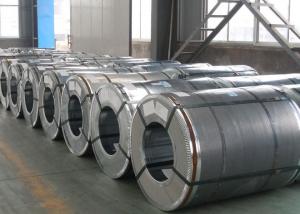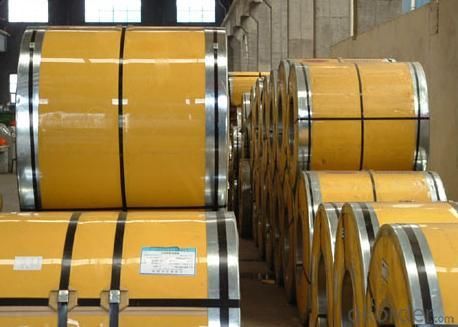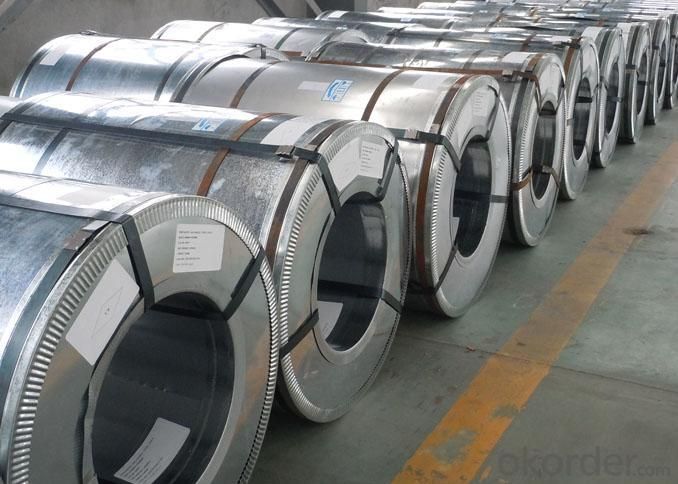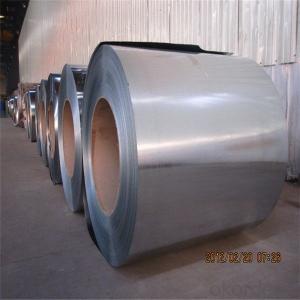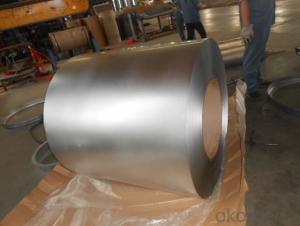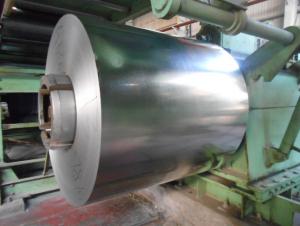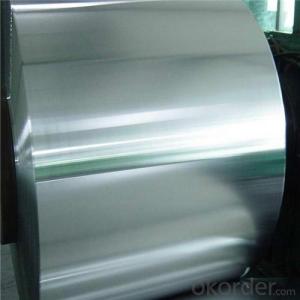Aluzinc Steel Coil- AL 55%
- Loading Port:
- China Main Port
- Payment Terms:
- T/T or L/C
- Min Order Qty:
- 25MT m.t.
- Supply Capability:
- 5000mt/per month m.t./month
OKorder Service Pledge
OKorder Financial Service
You Might Also Like
General Information Of Galvalume Steel Coil AZ150
With Cold Rolled Steel as base metal,with the aluzinc coated, finally the plate steel is called galvalume steel. Galvalume steel is good capable of decoration, molding, corrosion resistance. It generally displays superior workability, durability and weather resistance.
Thickness 0.23-1.2mm (BMT) |
Zinc Coating 80-275g/m2 |
Color According to RAL color fan |
Internal Diameter 508mm or 610mm |
Coil Weight 4-8MT |
Quality Commercial and structural quality |
Paint Polyester paint for topside, epoxy for reverse |
Standard JIS G 3312, ASTM A755M, EN 10169 |
Base Steel Grade SGCC,SGCD,DX51D+Z,DX52D+Z;S200GD,S220GD, S280GD,S350GD,CS,FS,SS |
Chemical Composition Of Aluzinc Steel
C | Si | Mn | P |
0.04-0.06% | 0.01-0.03% | 0.18-0.22% | 0.014-0.016% |
Technical Data Of Aluzinc Steel
Yield Strength | (Mpa) 280-320 |
Tensile Strength | (Mpa) 340-390 |
Elongation | 20%-30% |
Reverse Impact | 9J |
T-bending | ≥2T |
Pencil Hardness | ≥2H |
Duration Of Salt Spray Test | 500 H |
Bending At 180 Degree | No crack, purling and fraction |
Application Of Aluzinc Steel
Outdoor:
roof, roof structure, surface sheet of balcony,
frame of window, door, door of garage, roller shutter door, booth, Persian blinds, cabana, etc.
In door:
door, isolater, frame of door, light steel structure of house, home electronic appliances, etc.
Packaging & Delivery Of Aluzinc Steel
Anti-damp paper inside full wrapped with plastic film, iron sheet outside on wooden pallet in 20 feet container with 25mt.
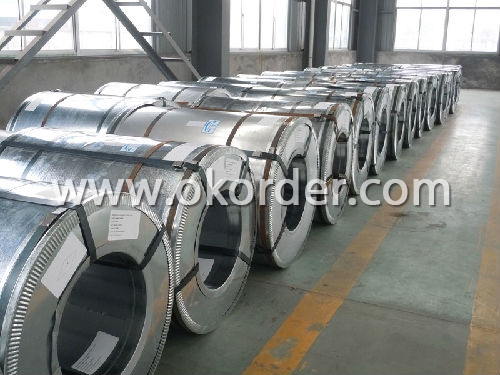
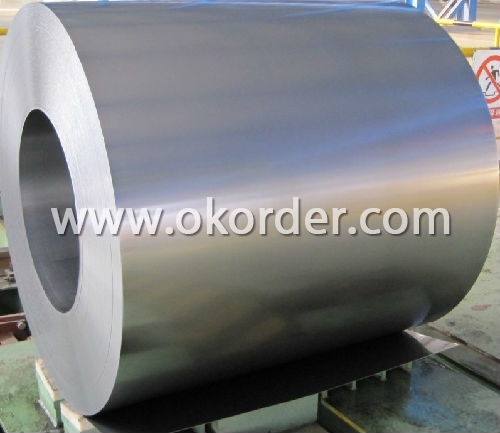
- Q: Molten steel changes to solid steel at its __________ point. Could you please fill in the blank? Thank you so much, it is greatly appreciated. I have been looking for the answer to this question for a long time, but I never understand what the websites are trying to say because I don't have that big of a vocabulary and don't know what they mean. I've seen things saying steel boiling point, steel melting point, and steel freezing point. I don't know what any of those mean, and they might be the answer. Please help me. Thank you.
- Carbon 'tempers' steel, by making it harder and less prone to bending (ductility). It fits the carbon atoms into the spaces in between the crystal lattice structure of the iron atoms. Too much carbon means the steel becomes more brittle, harder to weld and thus more likely to shatter under stresses which are perpendicular (shear forces) to the crystal structure of the molecules. It also is very difficult to work, requiring very high temperatures.
- Q: What is the difference between carbon steel and spring steel?? And which is the better one to make swords with??
- All steel has carbon in it. If too much carbon is in the steel it is extremely hard and brittle. Like cast iron. The only difference between iron and steel is the level of carbon. Cast iron is very hard. A drill can barely drill thru it unless you treat it with something like cobalt or titanium nitride. But if you hit cast iron with a hammer very sharply it will break into pieces from the shock. Too low of carbon causes problems though. Steel is very flexible and machinable when it has very low carbon, but it also doesn't wear very well. If you made a sword out of low carbon steel, it would bend very easily and the edge would get dull quick. If you bent it, it wouldn't spring back either. That gets us to spring steel. This is just the right amount of carbon so the steel is very hard and the sword can hold an edge. It also gives it shock resistance. You can bend the sword and it returns to it's original shape. That is why it is called spring steel. The steel resists bending and when it does bend, as long as it isn't to far, it springs back when let go, to it's original shape
- Q: When steel is cast, does it become weaker/more brittle or anything of this nature? what are the side effects of steel casting on the steel itself?How can you correct these?
- It contains too many air bubble spacing and too many impurity that make it easily to be broken apart. Melt it down again with high heat to remove most impurity, after this process,it becomes iron.
- Q: I know aluminum is lighter but I'm looking at a 01 bianchi grizzly mountain bike which is steel. I used to ride a specialized stumpjumper m4 which was aluminum. It was quite light so I don't know if I'll like a bit heavier bike but overall what is better from those who have had both?
- I've ridden steel, alum, Ti and carbon. I like 'em all. It all depends of craftsmanship and design IMHO. Really, a light steel frame is only about 1 to 1.5 lbs heavier than other super light frames. Steel has a rep for being heavy and most of that comes from being a heavier duty frame and being spec'ed with heavier parts. With that being said I have 2 alum and 1 carbon framed bikes now. I owned several steel bikes in my day, loved 'em too. I like light and if you're a weight weenie too you may not want a heavier bike regardless of material. The Stumpjumper is a sweet light bike. If the Grizzly is up to your specs give it a go. Thats how you experience life. Try something different. You'll like the feel of steel, as of the bike? Only you will know if you like it or not.
- Q: How are steel coils shipped internationally?
- Steel coils are shipped internationally using various methods to ensure their safe and efficient transportation. The most common method is through container shipping, where steel coils are loaded into standard shipping containers for transportation. These containers are specifically designed to handle heavy and bulky cargo, such as steel coils. To load the steel coils into the containers, they are usually stacked horizontally and secured with steel strapping or metal bands to prevent movement during transit. This ensures stability and minimizes the risk of damage. Additionally, wooden or metal dunnage may be used to separate and secure the coils to further prevent shifting. Once loaded, the containers are sealed and transported to the port using trucks or trains. At the port, the containers are loaded onto cargo ships, either by crane or using specialized equipment such as roll-on/roll-off (RO-RO) vessels or semi-submersible ships. These ships provide a secure environment for the steel coils during the journey, protecting them from weather conditions and potential damage. During the voyage, the steel coils are subjected to various safety measures to prevent corrosion and protect their integrity. These measures include applying protective coatings, such as oil or special paints, and using desiccants or humidity control systems inside the containers to regulate moisture levels and minimize the risk of rusting. Upon reaching the destination port, the containers are unloaded from the ship and transferred to trucks or trains for further transportation to their final destination. At this stage, the steel coils may undergo customs clearance and inspection procedures before being delivered to the intended recipients. Overall, international shipping of steel coils involves meticulous planning, secure packaging, and the use of specialized containers and equipment to ensure their safe and successful transport.
- Q: What are the common surface defects in steel coils?
- Common surface defects in steel coils include scratches, pits, indentations, stains, and rust spots. Scratches can occur during handling or processing of the steel coils and can vary in depth and length. Pits are small depressions on the surface of the coil and can be caused by impurities in the steel or during the manufacturing process. Indentations are similar to pits but are usually larger and more noticeable. Stains can be caused by various factors such as chemicals, water, or other contaminants coming into contact with the steel surface. Rust spots occur when the steel is exposed to moisture or corrosive elements, leading to the formation of iron oxide. These defects can affect the appearance, quality, and performance of the steel, and it is important to address them to ensure the desired end-use of the coils.
- Q: What is the major disadvantage of hardened steel? Do you think this form of iron would be wear resistant and retain a sharpened edge?
- a disadvantage is the fact that the cold forming capability of this steel
- Q: What materials are used to make steel coils?
- Steel coils consist primarily of steel, an alloy primarily composed of iron and carbon. The choice of steel type for coil production depends on the desired properties and applications. Carbon steel is typically the preferred option due to its strength, durability, and versatility. Additional alloying elements, like manganese, silicon, nickel, or chromium, may be incorporated to enhance specific steel characteristics or properties. To produce steel coils, the raw materials are melted, the molten steel is refined, and specialized equipment and processes are employed to shape it into coils.
- Q: How are steel coils used in the manufacturing of automotive fenders?
- Steel coils are used in the manufacturing of automotive fenders by being processed and shaped into the desired form to create the outer structure of the fender. The coils are cut, bent, and welded together to create the necessary shape and strength required for a fender.
- Q: Obviously this is an easy question for anyone who works with metal. However, I am currently writing a book and had an idea that had to do with these two metals. Is it possible for gold to be folded into steel while it is being forged? Do 3-metal alloys exist? If this is not possible with current metal-working techniques and technology, what would be needed to make it possible? And finally, what exactly would the mixing of these two yield? A weak metal? A brittle metal? How would it compare to iron or gunmetal? If you have no idea, please offer speculations. Thank you!
- Well put it this way you cant gold steel but you can steel gold Kidding but seriously you can but ther would be no point the steel would be weaker and gold is expensive
1. Manufacturer Overview
| Location | Wuxi, China |
| Year Established | 2002 |
| Annual Output Value | US$1 Million - US$2.5 Million |
| Main Markets | Mid East Northern Europe North America Eastern Asia Africa Eastern Europe Southeast Asia Western Europe Southern Europe |
| Company Certifications | ISO 9001;ISO 14000 |
2. Manufacturer Certificates
| a) Certification Name | |
| Range | |
| Reference | |
| Validity Period |
3. Manufacturer Capability
| a) Trade Capacity | |
| Nearest Port | Shanghai |
| Export Percentage | 1% - 10% |
| No.of Employees in Trade Department | 50 |
| Language Spoken: | English; Chinese |
| b) Factory Information | |
| Factory Size: | Above 600,000 square meters |
| No. of Production Lines | 10 |
| Contract Manufacturing | OEM Service Offered |
| Product Price Range | Average |
Send your message to us
Aluzinc Steel Coil- AL 55%
- Loading Port:
- China Main Port
- Payment Terms:
- T/T or L/C
- Min Order Qty:
- 25MT m.t.
- Supply Capability:
- 5000mt/per month m.t./month
OKorder Service Pledge
OKorder Financial Service
Similar products
Hot products
Hot Searches
Related keywords
